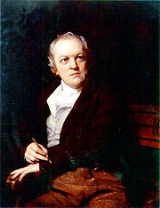
poet, painter, and printmaker. Largely unrecognised during his lifetime, Blake is now considered a seminal figure in the history of both the poetry and visual arts of the Romantic Age
. His prophetic poetry has been said to form "what is in proportion to its merits the least read body of poetry in the English language". His visual artistry has led one contemporary art critic to proclaim him "far and away the greatest artist Britain has ever produced".
Reason, or the ratio of all we have already known, is not the same that it shall be when we know more.![]()
The true method of knowledge is experiment.![]()
There can be no Good Will. Will is always Evil; it is persecution to others or selfishness.![]()
If a thing loves, it is infinite.![]()
Does the Eagle know what is in the pit? Or wilt thou go ask the Mole? Can Wisdom be put in a silver rod? Or Love in a golden bowl?![]()
Nothing can be more contemptible than to suppose Public RECORDS to be True. ![]()
That the Jews assumed a right Exclusively to the benefits of God. will be a lasting witness against them. & the same will it be against Christians![]()
Degrade first the arts if you'd mankind degrade, Hire idiots to paint with cold light and hot shade.![]()
To Generalize is to be an Idiot. To Particularize is the Alone Distinction of Merit — General Knowledges are those Knowledges that Idiots possess.![]()
The Foundation of Empire is Art & Science Remove them or Degrade them & the Empire is No More — Empire follows Art & Not Vice Versa as Englishmen suppose.![]()

